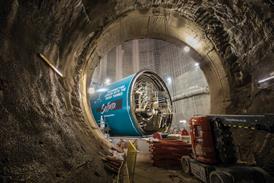Do this month’s two major takeovers show the market finding its feet?

After a year-long lull, major takeover activity returned dramatically to construction industry headlines this week, first with Galliford Try’s purchase of Miller Construction and then, days later, with Aecom’s £2.3bn mega deal for rival consultant URS.
Exactly one year after the last major acquisition in UK construction completed - Kier’s hard won battle over May Gurney - this week’s two deals put a firm marker in the sand for other firms weighing up their strategic options in a post recession market.
Aecom’s buy means it will be the largest consultant in the UK, pushing it above Atkins in terms of staff numbers. In the world of contractors, Galliford Try’s move for Miller has doubled its construction order book overnight.
Each of the deals had their own drivers. Aecom’s buy continues a drive for growth through acquisition that the engineering giant has been pursuing apace for years, and which is central to its business model.
Galliford Try’s purchase, on the other hand, is an opportunistic swoop for a respected business. Miller Construction came to market at a cheap price because of its parent company’s own strategic agenda, preparing for a stock market float as a housing-only firm.
Aecom’s buy means it will be the largest consultant in the UK, pushing it above Atkins in terms of staff numbers. In the world of contractors, Galliford Try’s move for Miller has doubled its construction order book overnight
But taken together, the two deals show that the trend for consolidation among the industry’s largest players that started to emerge in the early days of recession, mainly among consultancies, but also, to some extent, in contracting, is still very much alive as the market picks up.
This is significant because it comes despite much publicised difficulties with integration on several recent large scale deals (including Aecom’s acquisition of Davis Langdon).
This could feasibly have acted as a brake on major takeovers while the market found its feet again - such deals add an extra layer of risk into businesses already grappling with rapid cost rises and legacy contracts.
The reemergence of consolidation - particularly in respect of the seismic Aecom deal - is also significant because it comes despite persistent background rumblings over whether some clients are reluctant to work with large-scale firms.
But, in fact, despite those rumblings, and government talk of embracing smaller firms and regional supply chains, there is plenty of evidence to suggest that size continues to confer advantage, in both consultancy and contracting.
Just look at the Education Funding Agency’s newly created small and medium sized project framework, which is dominated by national contractors to the exclusion of many regional businesses. And, with the market gathering pace, whatever sector you work in, acquisition gives you at least a short-term solution to a very pressing problem: the scarcity of bid managers and experienced staff.
So, do this week’s events add up to the start of a return to widescale M&A activity in construction?
The short answer is, not in themselves: the drivers for these deals clearly extend beyond general market conditions into the specific circumstances of the firms involved. But what both deals do is put expansion, specifically through acquisition, firmly on the agenda in their respective market places.
A new competitive landscape is emerging in construction and other players in the industry must now assess whether the way to traverse it is through following the path of sudden growth.
The pressure on companies to place their bets is growing.
Sarah Richardson, editor



























No comments yet